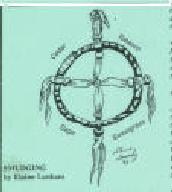Hi Karen,
Thank you for your wonderful post. Very interesting. I have been reading a lot in here.
I like this one on Smudging, got to print it out.

Smudging by Elaine Lunham Virginia Graverette Pigeon, Tribal Elder of the Saginaw Chippewa Tribe, member of the Cedar Women's Society, Elder of the Mide Lodge. With these credentials, I realized that Virginia holds a lot of wisdom, guidance, and teachings.
For as long as I can remember, I had heard of the Anishinabe people smudging with sacred herbs such as tobacco, sweetgrass, sage, and cedar. I always wondered the meaning behind it (though I had my own ideas).
One day I went to Virginia, seeking answers to my questions, trying to gain insight and knowledge so that one day I could pass this on to my children and their children. Virginia began by saying that some people follow the Traditional Way and some follow the Christian Way and that one way respects the aspects of both ways. Both know one God.
Virginia said that there are a lot of stories and legends that have been brought down from generation to generation. She said that there are a lot of reasons why we should smudge and that it is a good thing to smudge, either with one of the sacred herbs or all of them together.
She said: In the first place, tobacco (a-say-ma) was a gift of the Four Manido (Spirits of the Four Directions). It was the father of Nanabush who gave the tobacco (ah-say-ma) and shared the custom of smoking with his son after their epic battle in war, as a symbol of peace. Nanabush in turn passed on the custom to the Anishnabe as a ceremony. Thereafter, the Anishnabe smoked the Pipe of Peace before great councils, after war, and before other ceremonies. The Anishnabe adopted the custom and made it part of their daily lives to compose their minds and spirits. It is said that it will chase away feelings that are bad or negative and bring on thoughts that are good or positivie.
In the second place, tobacco (ah-say-ma) was in the nature of an incense, sweet to the taste and fragrant to smell. No other plant is endowed with such qualities. Cedar was offered to the fire to smudge the lodge and people. It is also used to waft the smoke to ward away sickness.
There are no absolutes with sage and sweetgrass.
In the above medicine wheel which we convey as the wheel of life, there are Four Directions. When we are born, life begins in the East. The teenage years are in the South. Then mid-life is in the West. When we reach the North, we are grandmas and grandpas and nearly ready to go to the Spirit World as we have done our many deeds on Mother Earth. The journey does not end in the North because we go to the Spirit World and then the cycle continues.
We gain knowledge with our tobacco (ah-say-ma) and we grow spiritually. Our hearts feel and our spiritual eyes have to see what our Creator wants us to learn. We feel the knowledge in our soul, and we know it comes from our Creator. When we pray, we get answers, then we are nurtured and we grow spiritually.
Smudging helps us center ourselves with the four sacred herbs mentioned: tobacco (ah-say-ma), sweetgrass, sage, and cedar. We begin by using a shell or bowl with a fan or feather. We then smudge the room, slowly walking clockwise around the perimeter of the room, fanning the smudge pot, keeping it lit and wafting the smoke about. Smudge any medicine tool you will be using such as pipe, jewelry, outfit, etc.
It is a good practice to smudge each person in a group, circle, ceremony, and lodge. Starting from the East and holding the smudge pot lit, each person can bathe themselves in the smoke. Many people smudge the heart area first, next the head area, and then the arms, then downward toward the legs. This isn't the only way you can smudge. It isn't wrong to smudge another way. We can purify and cleanse fairly regularly in this day and age with so much sickness and bad feelings around.
For more information on legends and stories, a good book to read would be Ojibwa Heritage by Basil Johnson or ask an elder and offer tobacco.
Hugs,
Myrna